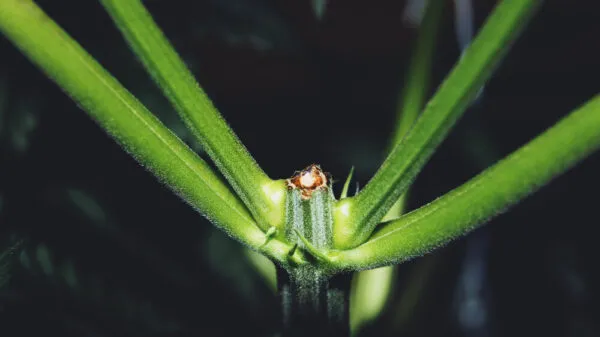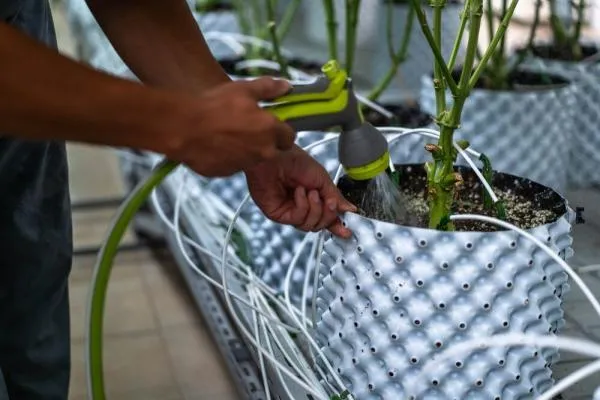What is fimming?
Fimming is a high stress training (HST) method that you can use to increase the yield of a cannabis plant. It is very similar to topping, the main difference is how much of the plant that you remove. With topping you cut off the entire top of the central stem above the fourth node, this results in two apex stems growing instead of one.
Similarly, with fimming you cut the top of the main central stem, but you only remove 75% of it, leaving behind the remaining 25% that looks like a little tuft of stem. The name 'FIM' is an anacronym for ‘f*ck I missed’ which is a nod at the way that it looks like a badly topped cannabis plant. The tuft of stem left behind then grows into four new shoots instead of one, resulting in multiple large bud sites.
- What is fimming?
- What are the benefits of fimming?
- What are the downsides of fimming?
- When should you start fimming a plant?
- Is topping or fimming better?
- How often can you fim a cannabis plant?
- How long does it take a plant to recover from fimming?
- Can you FIM after topping?
- Can you fim autoflowering strains?
- What training methods are better suited to autoflowers?
- How to FIM a Marijuana Plant
What are the benefits of fimming?
Bigger Yields: Fimming and topping both encourage the growth of multiple main colas instead of just one, leading to a bigger overall yield.
Bushier Plants: By removing the growth tip of a cannabis plant, it encourages side branching and a more compact growth structure.
Improved Light Penetration: With more lateral growth, light is able to reach more leaves because of the wider canopy, resulting in improved growth and bud development.
Improved Quality: Fimming allows you optimize the shape of a plant for light absorption, allowing the plant to direct more energy to bud production. This results in an improvement of bud quality and potency.
What are the downsides of fimming?
Stress: Cutting cannabis plants while they are young causes stress. If done too close to the flowering stage your plants won't have enough time to recover resulting in reduced yields. You can fim autoflowers but you need to be incredibly careful as it is not suitable for all autoflowering strains.
Increased Risk of Disease: It is very important to use sterilised scissors to fim a cannabis plant as it can increase the risk of disease and pest problems by creating more entry points for pathogens to enter the plant.
When should you start fimming a plant?
You should start fimming in the early vegetative stage when the plant has 4-6 nodes. At this stage your plants will be strong enough to handle some stress and still have plenty of time to recover and develop before reaching the flowering stage.
Fimming autoflowers can be a little bit trickier because of their shorter vegetative and flowering phases. If you are fimming autoflowers you should only attempt it when growing Sativa-dominant seeds because they have longer vegetative and flowering stages. However, ideally it is best to use other low stress training methods with autoflowers instead.
Is topping or fimming better?
Topping and fimming are two different plant training techniques used in cultivation to control plant growth and increase yields. They both generate very similar results and there is no one "better" method. You can also fim a plant using the pinching method instead of fully cutting the stem. When you do this correctly it is less stressful to the plant, so this could be a better alternative to topping. That being said, topping a plant encourages it to grow laterally and reduces its height, which means it could be better suited if you are an indoor grower with limited space. Ultimately, both methods can be effective, but the choice will depend on the grower's goals and experience.
How often can you fim a cannabis plant?
There isn’t one answer for how often you can fim a cannabis plant because it depends upon the strain, stage of growth and its health. Generally, fimming can be done once every 2-4 weeks during the vegetative stage of growth. However, it's important to monitor the plant's response each time you fim and adjust the frequency as needed. If the plant exhibits any clear signs of stress, avoid any fimming until it has fully recovered. Over-fimming can cause stunted growth and reduced yields, so it's essential to use this technique carefully and in moderation.
How long does it take a plant to recover from fimming?
It depends on the type of plant and how the plant responds, some strains may exhibit signs of stress and take a little longer to recover than other. If it is done correctly it should take about 7 to 14 days for a plant to recover from fimming.
Can you FIM after topping?
Yes, it is possible to FIM after topping cannabis. Topping involves cutting the growing tip of the plant to encourage branching, and FIMming can be done to further stimulate branching after topping. However, each and every time you use fimming or topping it will slow or halt a cannabis plants growth while it recovers from the stress it endures. So Fimming after topping can be done but isn’t necessarily advised.
Can you fim autoflowering strains?
Yes, you can fim autoflowering strains, however the question that to be asked is should you fim autoflowering strains? The answer is probably no.
Autoflowering strains flower according to time and not light, which means at week 3-4 they will begin flowering regardless of what light cycle they are under. This poses a problem for fimming because it means that the window for recovery is massively reduced.
With photoperiod weed strains after a plant has been fimmed, the vegetative stage can be extended for a few more weeks to allow the plant plenty of time to recover and grow its new shoots. With autoflowering plants, you don’t have the luxury of doing this. Therefore, you may end up fimming just before the plant begins to flower. This will most likely result in stunted growth and smaller yields which defeats the object of training in the first place. Ideally fimming will give you the best results when done on a high yield photoperiod strain such as Big Bud or Critical.
What training methods are better suited to autoflowers?
Topping and fimming autoflowers is just too risky, and you may end up with lower yields so its probably not worth it. Alternatives to fimming are low stress training (LST) methods such as ScrOG and the tie and bend approach which can easily be implemented with autoflowers to increase yields while causing very little stress to the plant. For a complete guide on other growing methods that will be more suited to autos, visit our page on cannabis plant training.
How to FIM a Marijuana Plant
Fimming is very similar to topping and the process is much the same. The only real difference is that you’re not cutting your plant.
Wash your hands so they are very clean.
Carefully grasp the area between the nodes and pinch the stem slightly. You don’t want to break it, but you do want to damage it slightly.
Remove some of the new, top growth.
It’s important that when topping or Fimming, you only do it in the vegetative stage. It’s best to start with young plants that have developed at least five nodes when topping and at least three when Fimming.
There are many reasons growers train their marijuana plants. They may want to increase the yield, see more colas form, or just reduce the height of their plant. Topping and Fimming are two proven techniques that will help you do all of that. Before choosing which method to use, it’s important to consider the pros and cons of each. From this, all growers can form their own personal preference and master the tricks to getting more from their plants.










